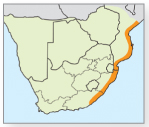
6 |
Text by Chris Appleton and Nelson Miranda |
|---|---|
Molluscs have an unsegmented body, divided into a head, a visceral mass incorporating the body organs, and a muscular foot. The body is normally contained within a hard shell made of calcium carbonate. Two classes occur in fresh water, the Gastropoda (snails and limpets) and the Bivalvia (mussels and clams). Gastropod shells are asymmetrical and usually coiled, but the coiling may be sinistral (‘left-handed’; aperture faces the observer’s left-hand side when viewed with apex upwards) or dextral (‘right-handed’; aperture faces the observer’s right-hand side when viewed with apex upwards). The shells of bivalves are comprised of two matching halves (valves) hinged together dorsally. Most large bivalves have shells that are longer than they are high, but in small species the reverse may be true. Prosobranch gastropods, which are almost all dextral, close their shell’s aperture with an operculum or ‘trapdoor’, obtain oxygen from the water using gills, and have separate sexes. Pulmonate gastropods, which can be dextral or sinistral, lack opercula and gills, get oxygen from the air via the mantle and are hermaphrodites. Both groups feed largely on decaying organic matter and detritus. Bivalves mostly burrow into sandy or muddy sediments, using their muscular foot, and open and close their valves using powerful adductor muscles. They filter food from water passing through their sieve-like gills. Most are separate sexed. In southern Africa there are approximately 90 species of freshwater gastropods, belonging to 16 families; plus 25 species of bivalves, belonging to six families. Several members of the pulmonate families lymnaeidae and Planorbidae are of medical and/or veterinary importance. Alien snails are common and continually being introduced, but no alien bivalves are reported from the region. Measurements relate to shell length, or length × width.
Operculate gastropods
The nerites
Family Neritidae
Many members of this family are marine, but three species of Neritina and one of Septaria occur in the lower reaches of east coast rivers, and in brackish water bodies that experience tidal influence.
1 Freshwater nerites
Neritina species


© N. MIRANDA
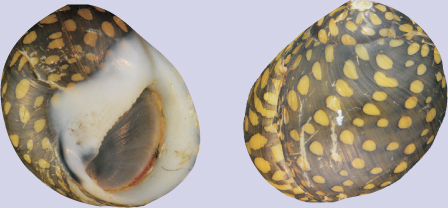
© N. MIRANDA

© N. MIRANDA
Shell thick and hemispherical with a D-shaped aperture, glossy white columella (or axis) and calcareous operculum. The three species are distinguished by the colour patterns of their shells. Because the columella is broad and masks much of the front of the shell, these patterns are most clearly seen on the back, which is also illustrated. N. gagates (1) is black or brown, overlying a pattern of paler zigzag lines. N. natalensis (1a) has yellow-brown spots and bands, while in N. pulligera (1b) the shell is uniformly black. Size: Shell 15–20×20–23mm. Biology: Live in flowing water, attached to hard surfaces, such as exposed rock faces and Phragmites stems. Nowhere common. All have similar distribution patterns.
2 Réunion Island septaria
Septaria borbonica
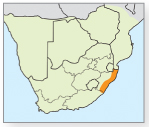
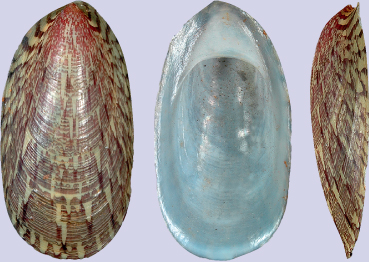
© D.HERBERT

© D.HERBERT

© D.HERBERT
Shell limpet-like, with apex at posterior end and usually overhanging the shell, pale brown and green with a darker reticulate pattern. A pink form (2a) is also found. Size: 30×25mm Biology: Males generally smaller than females and have a cephalic penis on left side of head. Operculum reduced so that, unlike Neritina species, a Septaria cannot close its aperture. Lives in flowing water. Shell shape varies from elongate to nearly circular according to nature of the surface occupied. Specimens from KwaZulu-Natal are generally elongate and occur in the lower reaches of rivers, on rocks and reeds such as Phragmites. This form previously called S. tessellaria (2b), but now considered synonymous with S. borbonica from the Indian Ocean islands. Not common; categorised by IUCN as Endangered.
3 River snails
Family Viviparidae
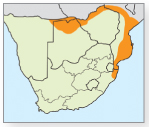
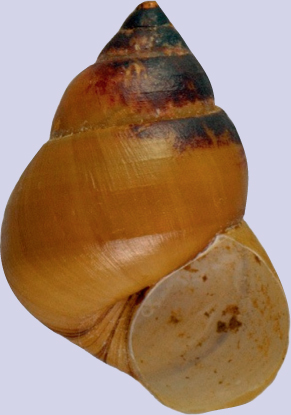
© N. MIRANDA
Medium-sized, dextral, turbinate shells with corneous operculum. Two species in the region. The Bristled river snail (Bellamya capillata) (3 and map) is uniform pale brown, with a circular aperture. Apical whorls have small bristles, but these are easily missed. Size: 60×45mm. Biology: Viviparous, embryos developing in the brood pouch of female and born alive. Right tentacle modified to function as a penis, but no males found in northern KwaZulu-Natal, so these populations probably parthenogenetic. Occurs on sand and silt in permanent lakes, rivers and shallow seasonal pans. Has been displaced in Lake Sibaya by the invasive thiarid Tarebia granifera (p.128, 2). RELATED SPECIES: B. monardi occurs in south-central Africa and has a larger, more globose shell.
Apple snails
Family Ampullariidae
Three species each of Pila and Lanistes and one introduced South American species of the genus Pomacea known from the region. Shells mostly large, smooth, >20mm in height, globose or ovate, with corneous opercula. Umbilicus narrow. All dextral except Lanistes, which is sinistral. Differ from other prosobranchs by having a lung as well as a gill, enabling them to live in both permanent and seasonal water bodies. Survival in seasonal habitats helped by aestivation in dried sediments for months at a time. Both jaw and radula strongly developed, allowing these snails to feed on living aquatic vegetation.
1 Egg-shaped lanistes
Lanistes ovum
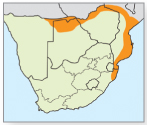
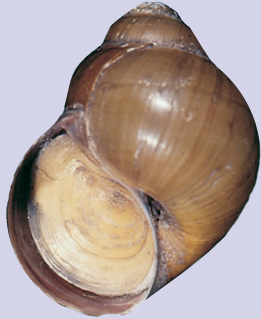
© C. APPLETON
Shell large, shiny olive green to brown, with a moderately high spire. Size: 59×44mm. Biology: Eggs laid in clusters on aquatic vegetation, especially under Nymphaea leaves. Became a pest in rice paddies in Swaziland in the 1960s, destroying rice seedlings. Many specimens were found in Iron Age midden deposits on the Kafue River, Zambia. Large specimens commonly eaten by African openbills (p.54, 7). RELATED SPECIES: The smaller L. neavei, usually with spiral bands, occurs in Zambia.
2 Western pila
Pila occidentalis
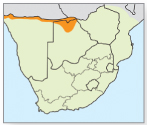
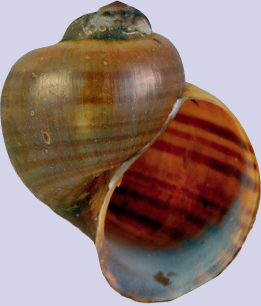
© N. MIRANDA
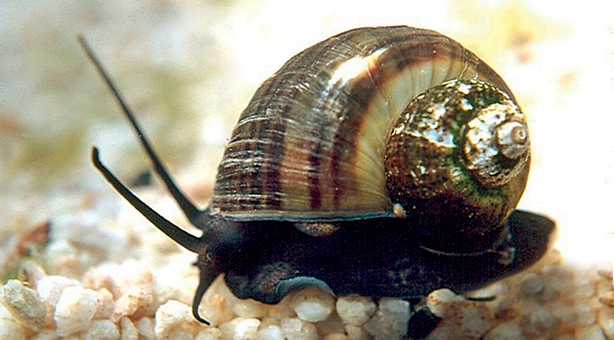
© C. APPLETON

© M. BRUTON
Shell globose, greenish brown with several darker spiral bands and a low spire. Size: 49×41mm. Biology: Egg masses laid in clusters on rocks and emergent vegetation just above the water line and are colourless. RELATED SPECIES: Introduced from South America, Pomacea diffusa (2a) is bred and distributed by the aquarium trade, usually as a yellow colour variety. Its presence is often indicated by its bright pink egg masses (2b), laid just above the water line. Not invasive, but may occur in artificial habitats anywhere in the region.
3 Vlei snails
Family Pomatiopsidae


© D. HERBERT
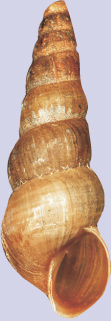
© C. APPLETON
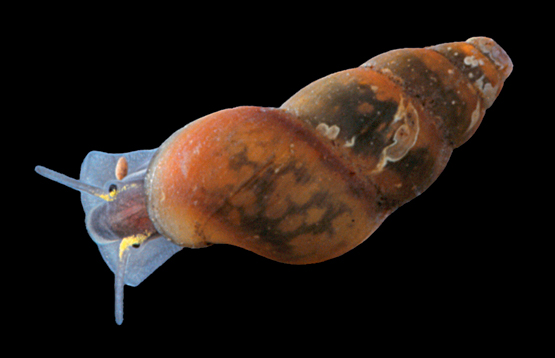
© D. HERBERT
Small dextral snails; shells with raised spire. Eyes in prominent swellings on outer bases of tentacles. Gills present. Male’s penis situated behind right tentacle. Crawl with a characteristic step-like movement. Occur predominantly in fresh water, but some are amphibious. In Vlei snails (Tomichia species) shell shape varies among the species (3, 3a), but typically elongate, whitish to dark brown, with spire usually eroded. Seven species in the genus, all endemic; T. cawstoni (3b) is typical. Taxonomy of the group uncertain. Size: 10mm. Biology: Often abundant. Habitats vary from fresh and brackish vleis to forest streams. Some tolerate high salinities and occur in large numbers in ephemeral saltpans. All species categorised as either Endangered or Critically Endangered by IUCN because of their restricted distributions, threats from development and habitat degradation. However, some fairly widespread and locally common.
4 Sentinel snails
Family Assimineidae
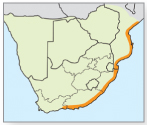
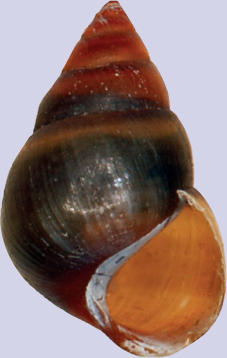
© N. MIRANDA
Small amphibious snails found in springs, rivers and streams, as well as estuaries and mangrove swamps along the coast. Sentinel snails (Assiminea species) (4) have elongate and smooth shells. Size: Up to 10mm. Biology: Sexes separate, egg capsules coated with mucus and pushed into the mud. Juveniles hatch as fully developed snails. RELATED SPECIES: Can be confused with other small snails, such as Hydrobia knysnaensis, but have much shorter tentacles. At least three assimineid species are reported: A. ovata (synonym A. capensis), A. globulus and Rissoa capensis. Their taxonomy is currently being revised.
Melania snails
Family Thiaridae
Medium-sized cone-shaped shells, with well-developed spire. Apical whorls typically worn in some species. Shell thick, sculptured in some genera, and with colour bands in others. Umbilicus closed, operculum corneous. Many species ovoviviparous, i.e. embryos develop in female’s brood pouch and are born alive. Males rare, even lacking in some species, which presumably breed by parthenogenesis.
5 Crowned melania
Thiara amarula

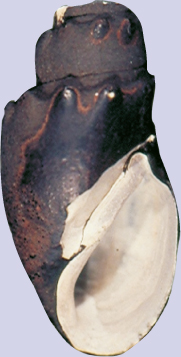
© C. APPLETON
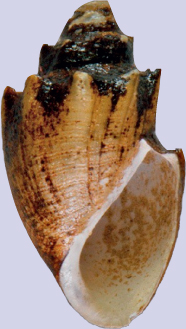
© N. MIRANDA
Unmistakable. Colour grey to black with contrasting white columella and interior; juveniles grey to brown. Apical whorls usually eroded. Tubercles on shoulders of whorls blunt in adults, but sharper in juveniles (5a) of <20mm shell height. Size: 38×20mm. Biology: A poorly known species found on muddy substrata in brackish rivers and streams that experience a tidal influence. May spread into lagoons and estuaries during periods of extended mouth closure.
1 Red-rimmed melania
Melanoides tuberculata
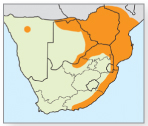

© H. MADSEN

© H. MADSEN
Dark brown, with sculpture of axial ribs, spiral grooves and tubercles and, sometimes, reddish flame-like markings. Size: 45×13mm. Biology: Occurs in rivers, lakes and dams. Tolerant of moderate salinities and also occurs in upper reaches of estuaries and even in middle reaches during periods of prolonged mouth closure. Several morphs exist, differing in sculpture and ornamentation, from smooth (1) to rough. The tuberculate morph (1a), which was common in the dry west, is now known only from relict populations in the subterranean Karstveld lakes of Namibia. In the east, Red-rimmed melania is being displaced by Quilted melania (see 2 below). RELATED SPECIES: M. victoriae has flatter whorls and less prominent sculpture. Commonly found in the Kunene and Okavango river systems and in Namibia’s Zambezi Region, but less so eastwards to the Mpumalanga Lowveld.
2 Quilted melania
Tarebia granifera
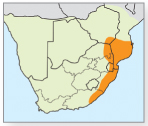
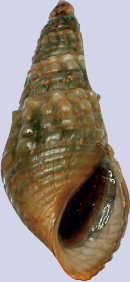
© N. MIRANDA
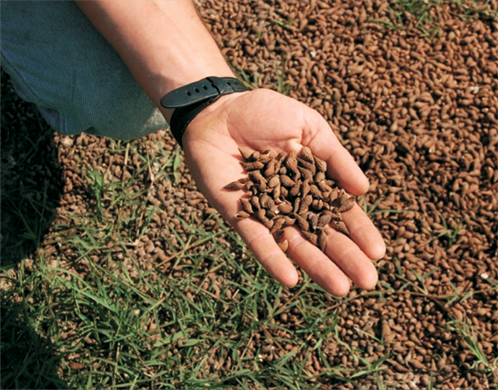
© G. CUMMING
Shell pale to dark brown, with conspicuous rounded tubercles, apical whorls of spire often worn. Size: 29mm. Biology: An invasive species from Asia that has spread throughout eastern South Africa and the coastal lakes of southern Mozambique. It has probably also reached Zimbabwe. Often present in enormous numbers (2a). Tolerant of high salinities, allowing it to invade estuarine systems, such as Amanzimtoti and St Lucia, and adversely impact indigenous snails in invaded habitats. However, T. granifera does not appear to significantly affect the benthic invertebrate biodiversity of coastal ecosystems, although under certain conditions some native aquatic snail species can be displaced. Known to block water pipes and damage pumps and filtration equipment.
3 Banded melania
Cleopatra ferruginea
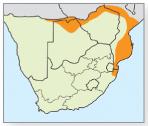
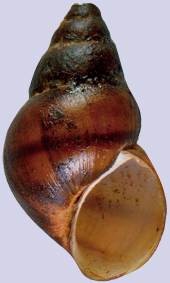
© N. MIRANDA
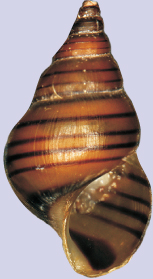
© C. APPLETON
Distinctive pale brown shells lacking sculpture, but with two or three dark spiral bands. Size: 20×12mm. Biology: Common in the shallows of pans, rivers and lagoons in the Okavango Delta. Also found in seasonal water bodies and has colonised irrigation canals in northeastern KwaZulu-Natal. RELATED SPECIES: C. elata (3a) and C. nsendweensis occur north of latitude 20ºS, but are not easy to separate. C. elata usually has multiple bands. Their distributions are poorly known.
Pulmonate gastropods
Pond snails
Family Lymnaeidae
Medium-sized dextral snails with thin brown shells that vary in shape even within a species. Spire pointed, basal whorl often markedly inflated and columella axis twisted. Tentacles flat and triangular, not long and slender, as in other pulmonate snails. Eggs laid on submerged surfaces in elongate, sausage-shaped, gelatinous masses curved slightly anticlockwise. Some species amphibious, but most do not aestivate well. All serve as intermediate hosts for liver flukes of the genus Fasciola, economically important parasites of sheep, cattle and, less commonly, people.
4 Common pond snail
Lymnaea natalensis


© N. MIRANDA
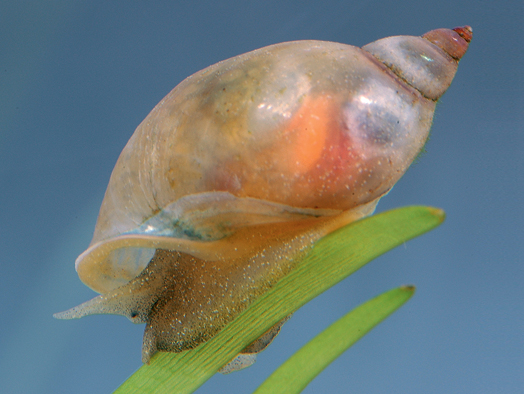
© H. MADSEN
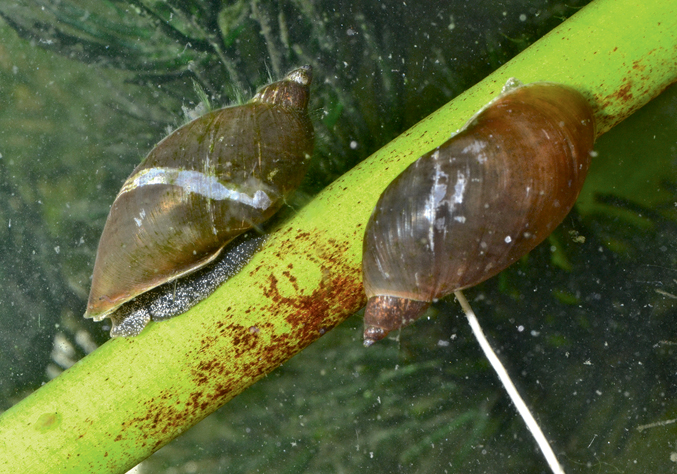
© C. GRIFFITHS
Shell pale brown, lacking sculpture except for growth lines, basal whorl inflated. Shell thin and fragile, mantle uniformly pigmented. Size: 22×14mm. Biology: Not amphibious. Intermediate host for Trichobilharzia species, common parasites of waterbirds, such as the Spur-winged goose (Plectropterus gambensis) (p.46, 3). Its cercariae frequently cause dermatitis (swimmers’ itch) in people swimming in fresh water. RELATED SPECIES: Radix rubiginosa (4a) grows larger and has a more robust shell. Mantle partially pigmented. Not amphibious. Occurs in aquaria and garden ponds in KwaZulu-Natal. Introduced from Asia. L. columella (4b) has a less inflated basal whorl, with characteristic reticulate sculpture. Amphibious and often found on damp mud at water’s edge. Introduced from North America; now widespread over southern Africa, except in the Kunene and Okavango systems.
5 Small pond snail
Lymnaea truncatula
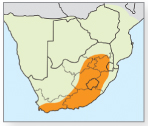
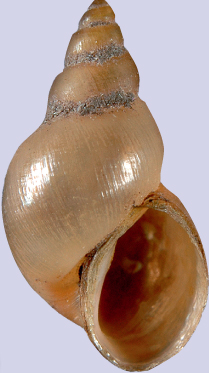
© D. HERBERT
Typically dark brown, basal whorl lacking sculpture and not markedly swollen. Size: 7–10mm. Biology: Amphibious and often found out of the water on damp mud around marshes and slow-flowing streams, seepages and irrigation furrows. Largely confined to the colder southern parts of the region and, in the east, mostly at altitudes over 800m. Common in bogs in Lesotho. Aestivates well. Often associated with human habitation and may have been introduced from Europe in the 18th century, or even earlier.
Ramshorn snails
Family Planorbidae
Eight genera of small to medium-sized brown snails with sinistral shells that may be disc-shaped, spirally coiled, or elongate in shape. Generally lack sculpture, except for growth lines. Umbilicus present in disc-shaped species. Tentacles long and slender, pseudobranch present. Egg masses flat and coiled clockwise, yellow in colour. Some species serve as intermediate hosts for the parasites causing human bilharzia.
1 Ribbed ramshorn snail
Gyraulus costulatus
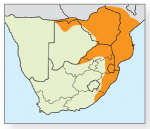
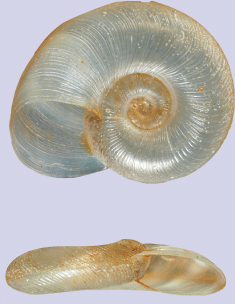
© D. HERBERT
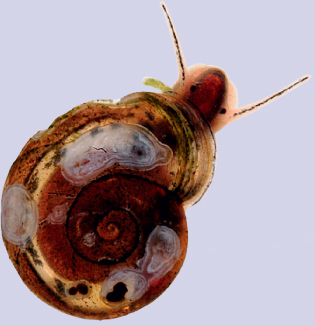
© H. MADSEN
Shell brown, greatly flattened, with rapidly increasing angular whorls and a sculpture of distinct regularly spaced ribs. Size: Diameter up to 6mm, height up to 1.5mm. Biology: Usually found in standing water, often on fallen leaves. RELATED SPECIES: G. connollyi has rounded whorls, and its ribs are less regular and closer together. Endemic to eastern South Africa. G. chinensis (1a), introduced from southern Asia, is known only from artificial ponds and aquaria. Distinguishable from native Gyraulus species by characteristic dark pigmentation on its mid-dorsal mantle.
2 Small ramshorn snails
Africanogyrus, Ceratophallus, Lentorbis and Segmentorbis species
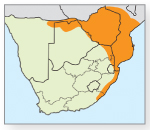
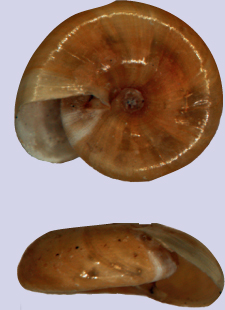
© N. MIRANDA
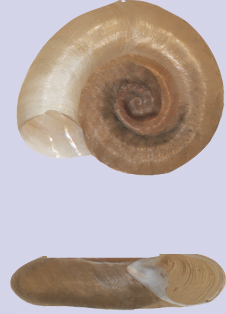
© N. MIRANDA
Small, discoid, brown snails with whorls increasing slowly in diameter, in contrast to Gyraulus (see 1, above) whose whorls increase rapidly. Seven species belonging to these four genera occur in the region, but are difficult to identify without dissection of their genitalia. Lentorbis and Segmentorbis (2) have glossy shells with radial folds visible inside the shell; Africanogyrus and Ceratophallus (2a) do not. Size: <8mm in diameter. Biology: Distributions not well known, but most occur in the eastern lowlands and probably more widely, some as far west as the Okavango Delta and Namibia. Species of Africanogyrus and Ceratophallus are partly sympatric in South Africa.
3 Pfeiffer’s ramshorn snail
Biomphalaria pfeifferi

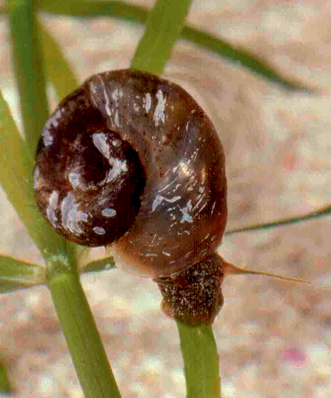
© C. APPLETON

© C. GRIFFITHS
Medium-sized, shell a flattened disc with rounded shoulder. Size: 5×17mm. Biology: Occurs in standing or slow-flowing water. Able to aestivate in dried sediments, but only for a few weeks. Serves as intermediate host for human intestinal bilharzia. RELATED SPECIES: Helisoma duryi (3a) can be mistaken for B. pfeifferi, but its shell grows larger and the whorls are more angular. Soft parts often reddish. Introduced from North America. Found in aquaria and garden ponds across the region, but not invasive.
4 Bubble snails
Bulinus species
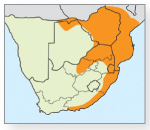
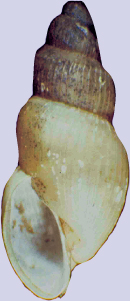
© C. APPLETON

© N. MIRANDA
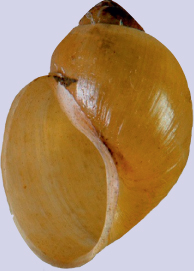
© N. MIRANDA
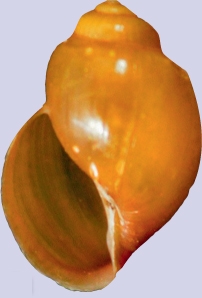
© N. MIRANDA
Medium-sized shells, usually globose with a short spire and inflated basal whorl, but some have high spires and basal whorl not inflated. Size: 25×13mm. Biology: Most species occur in perennial water bodies, but they are good aestivators. Some, such as B. forskalii (4), typically occur in seasonal water bodies. RELATED SPECIES: Nine species in southern Africa, but identification difficult. Widespread species include B. africanus (4a), B. tropicus (4b) and B. natalensis (4c). B. africanus (distribution shown in map) and the closely relatedglobosus serve as intermediate hosts for the parasites causing urogenital bilharzia in people and schistosomosis in cattle. B. tropicus carries the Conical fluke Calicophoron microbothrium, a common parasite of cattle.
Freshwater limpets
Tribe Ancylini
Small snails with limpet-like shells. Two genera, Burnupia and Ferrissia, occur in southern Africa. Variation in shell shape has led to many species of both genera being described, but taxonomic revision is likely to reduce this number. Egg masses like those of ramshorn snails.
5 Burnup’s freshwater limpets
Burnupia species
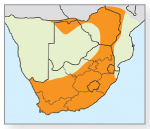
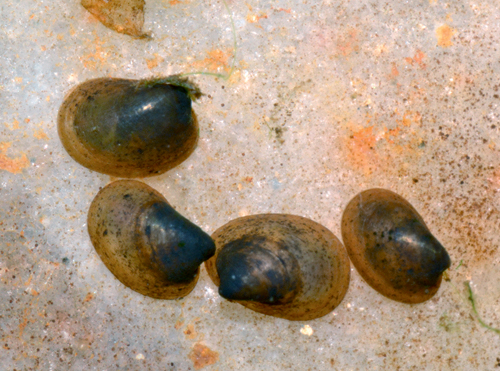
© C. GRIFFITHS
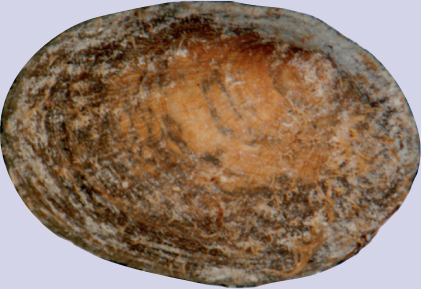
© C. APPLETON
Shells brown and appear asymmetrical, because apex is situated posteriorly and inclines to the snail’s right. Apical sculpture, which can sometimes be seen with a 10× hand lens, is a pattern of radial pits, see Ferrissia (5a); 14 species recorded from southern Africa. Size: Up to 10mm. Biology: Occur on submerged surfaces, such as rock and vegetation in well-oxygenated flowing and standing water. RELATED SPECIES: Ferrissia species (shown) are smaller, <5mm. Shell fragile with apex also inclined to the right, but less prominent. Apical sculpture a pattern of radial lines or ridges; 12 widespread species recorded from the region.
Bladder snails
Family Physidae
Medium-sized, shiny, sinistral shells with sharp spires and smooth texture. Edge of mantle digitate and partly projecting over shell. Physids have a unique set of muscles that enable them to flick their shells through an arc of about 120º. This reduces predation by preventing slow-moving predators, such as leeches, from attaching to their shells. Two American species are invasive and still spreading. Egg masses resemble those of Lymnaeidae, but are more convex, and eggs are laid in counterclockwise pattern.
1 Sewage snail
Physa acuta
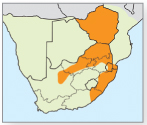
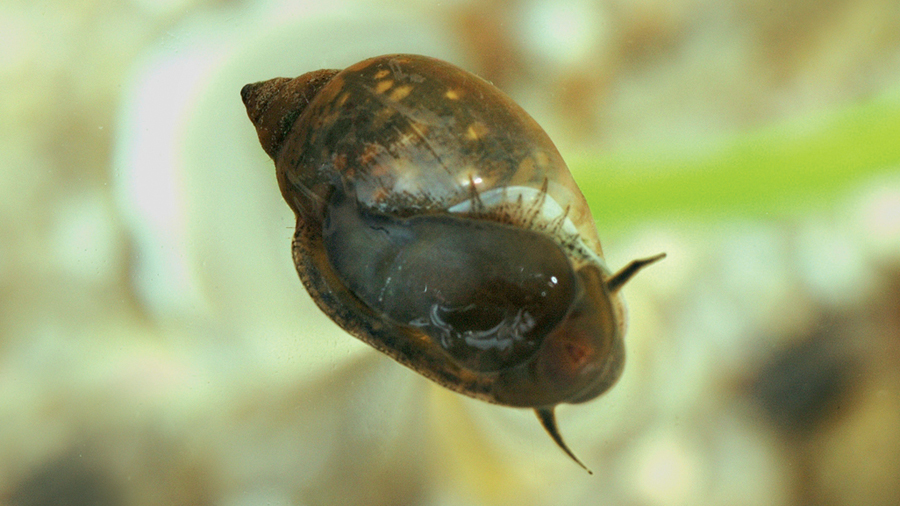
© H. MADSEN

© C. APPLETON
Mantle edge hardly extends over shell. Mantle roof pigmentation often visible through shell. Can be mistaken for a Bulinus. Size: 12×8mm. Biology: The most widespread freshwater snail in the world, originally from northwestern Europe or North America, and has now invaded water bodies of all types. Known as the ‘sewage snail’, because it tolerates organic pollution. Has displaced Bulinus globosus on Inhaca Island, Mozambique, reducing bilharzia transmission there. Occurs widely across the subcontinent, but not in Okavango system. RELATED SPECIES: Aplexa marmorata (1a) has a larger, more elongate shell with mantle edges extending over much of the shell. Introduced from South America and has spread over lowlands of KwaZulu-Natal, Mpumalanga and probably into Zimbabwe and Mozambique. Also known from Cape Town area. Does not occur in rivers.
Hollow-shelled snails
Family Ellobiidae
Small to medium-sized dextral snails with comparatively thick shells that resemble prosobranchs, but lack opercula. Shell walls typically hollow. At least one projecting fold (pleat) on inner lip of aperture. Tentacles rudimentary. Usually amphibious, occurring in brackish water in lagoons, estuaries and mangrove swamps. Spawn is a gelatinous mass and eggs hatch into veliger larvae. Seven genera in southern Africa, most occurring exclusively in estuaries and mangroves.
2 Mouse-eared snail
Myosotella myosotis


© N. MIRANDA
Shell ovate, tapering to a point, thin, usually smooth and morphologically variable. Size: 9–10mm. Biology: Previously called variously Alexia acuminata, A. pulchella, Phytia acuminata and P. myosotis and considered to be a native species. Now known to be a well-established invader introduced from Europe >120 years ago, possibly via dry ballast of ships. Occurs along the southern coastal strip, where it can be found under vegetation on the fringes of salt marshes and estuaries, particularly in areas where there is freshwater seepage. Occurs together with the Critically Endangered Tomichia tristis, which may be restricted to Aston Bay, Seekoeirivier Estuary.
Amber snails
Family Succineidae
Amphibious snails with slender fragile shells. Spire characteristically short, but body whorl and aperture large. Animal often seems too large for its shell.
3 Amber snail
Oxyloma patentissima
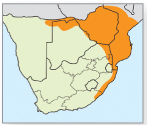
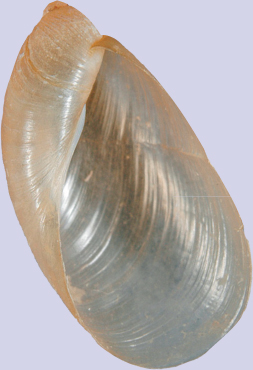
© D. HERBERT
Recognised by its transparent beige shell. Delicate brown markings on mantle visible through shell. Size: Up to 10mm. Biology: An amphibious species that occurs along watercourses and lagoons on marginal and overhanging vegetation, thus often collected with aquatic species in nets. In such situations it usually crawls out of the water in collecting jars. Can be misidentified as a species of Lymnaea (p.128, 4 and 5), but easily distinguished by its longer, more slender, retractile tentacles with eyes at the tips; by contrast Lymnaeidae have short, triangular, non-retractable tentacles with eyes at their bases.
Black mussels
Family Mytilidae
Bed-forming mussels, which attach themselves to hard surfaces using tough byssal threads secreted by a gland in the foot.
4 Brack-water mussel
Brachidontes variabilis


© C. APPLETON
Small brown to dark brown mussel, sometimes with red markings, hinge close to anterior (pointed) ends of valves; externally sculptured with well-developed ribs. Conspicuous denticles present internally on anterior rim of shell margin. Size: 30mm. Biology: Commonly clustered in large numbers on rocks, jetty pilings and reeds in coastal lakes, lower reaches of rivers and upper reaches of estuaries. Known to extend throughout estuaries during periods of prolonged mouth closure. RELATED SPECIES: May be confused with two estuarine species, B. semistriatus and Arcuatula capensis, but these lack denticles on the anterior internal shell margin and either lack an external ribbed sculpture or, if present, ribs weak.
Toothed river mussels
Family Unionidae
Medium-sized brown mussels. Not attached, but burrow into bottom sediments of rivers, pans, dams and, less commonly, lakes. Cardinal and lateral hinge teeth in both valves. Beaks anterior to median vertical line and usually worn to expose nacreous layer. Have an unusual larval stage that develops as a parasite on fish; these hosts then serve to distribute them (see also Iridinidae, below). Larvae probably host specific, so disappearance of a host fish from a habitat may cause the mussels to disappear as well. Members of this family and the Iridinidae are known for their remarkable longevity, most living for 5–6 years, but some for 10 or more.
1 Cape river mussel
Unio caffer
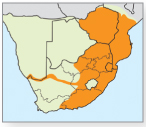
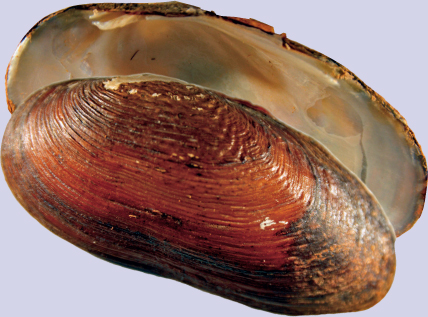
© C. APPLETON
Large robust mussel, sometimes called Cafferia caffer. Posterior end of adult shell angular in outline. Juveniles show zigzag sculpture over the shell, as well as growth lines; adults retain growth lines, but not sculpture. Size: Up to 87.3×46.6mm. Biology: Categorised as Near Threatened by IUCN, because its range is decreasing. Blister pearls occasionally found in large specimens (see Chambardia wahlbergi, 3 below).
2 Frames’ river mussel
Coelatura framesi
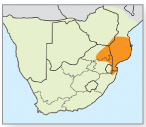
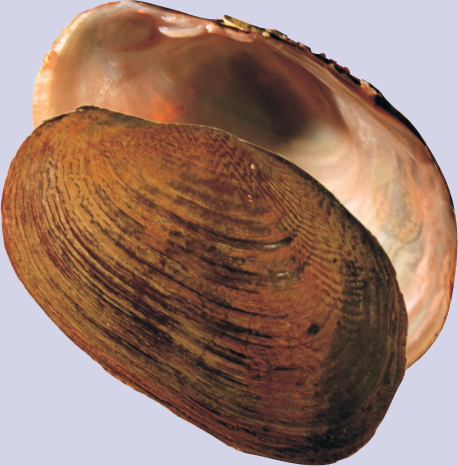
© C. APPLETON
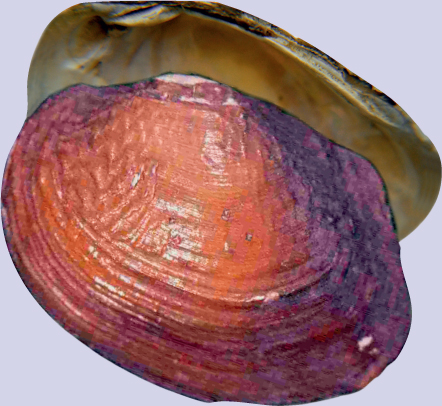
© C. APPLETON
Pale to dark brown shell, usually with weak radial sculpture on beaks and posterior end. Size: Up to 52×31mm. Biology: Limited to lowlands of northeastern southern Africa. Dominates benthos of Pongolo floodplain pans in northern KwaZulu-Natal. RELATED SPECIES: C. mossambicensis is smaller, and has a uniformly dark brown shell with radial sculpture around the beak. It occurs in east-flowing rivers of Zimbabwe and northern Mozambique, including the lower Zambezi and Lake Kariba. It may be conspecific with C. framesi. C. kunenensis (2a) has pale to dark brown valves with distinct zigzag or chevron sculpture and occurs in northern Namibia and Botswana. Many specimens ofC. mossambicensis have been found in Iron Age archaeological sites in southern Zambia, having been collected for food.
Toothless river mussels
Family Iridinidae
Medium-sized to large, long-lived, burrowing mussels lacking hinge teeth and without shell sculpture. Mostly dark brown, with growth lines sometimes protruding at posterior end. Beak situated slightly anterior to median vertical line; area around beak usually worn, showing nacreous layer. Conspicuous triangular extension of ligament present at posterior end of hinge plate in Aspatharia and Chambardia, but not Mutela. Like the Unionidae, iridinids have parasitic larvae that use fish as hosts and dispersal agents.
3 Wahlberg’s river mussel
Chambardia wahlbergi


© C. APPLETON

© C. APPLETON
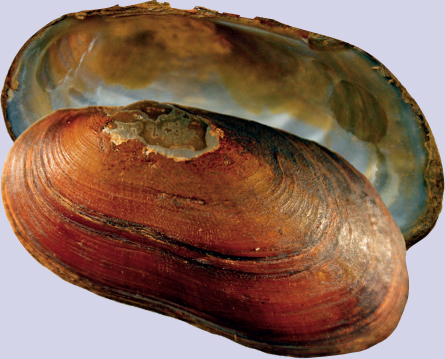
© C. APPLETON
Elliptical; interior nacre of valves often pinkish. Blister pearls may be found in large specimens (3a). Size: Up to 150×78mm. Biology: Occurs in both perennial and seasonal rivers, dams and floodplain pans, where able to aestivate for several years in dried sediments. May develop kidney stones when rehydrated after prolonged aestivation. The largest freshwater mussel in Africa; the largest South African specimens come from the Vaal River. Fishermen in KwaZulu-Natal collect large specimens for bait. RELATED SPECIES: Two smaller species in the region. C. petersi is elongate, lacks sculpture and is found in the east-flowing rivers of the Mozambique and Mpumalanga lowlands. Large numbers were found in an Iron Age archaeological midden in the Kruger National Park (see Coelatura kunenensis, 2 above). Aspatharia pfeifferiana (3b) is a robust species with a characteristically incurved ventral margin. It reaches its southern limit in the Kunene and Okavango rivers.
4 Zambezi river mussel
Mutela zambeziensis
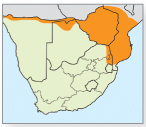
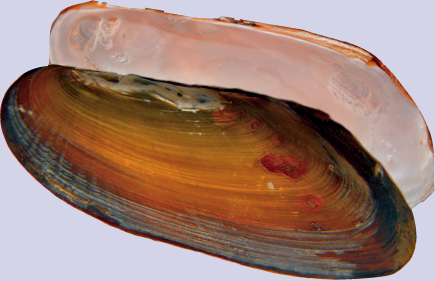
© C. APPLETON
Shell elongate without any sculpture. Adults greenish brown, posterior ends often distinctly truncate and ridged. Juveniles smooth, a beautiful iridescent turquoise. Beak typically very low and eroded. Size: 110×45mm. Biology: Handsome and common endemic species in the rivers of south-central Africa. Occasionally seen as far eastwards as the Mpumalanga lowveld and southern Mozambique. Previously reported as M. dubia, M. mabilli and M. rostrata.
River oysters
Family Etheriidae
Distinctive bivalves with irregular valves that lack hinge teeth. Unique among freshwater bivalves in that adults have only one adductor muscle. Cement themselves by either valve to rocks or other hard surfaces, usually in rapids in fast-flowing rivers, but also on rocky shorelines in lakes. The family consists of three closely related genera in Africa, India and South America, each comprising a single species.
1 African river oyster
Etheria elliptica
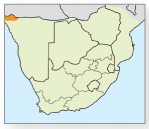
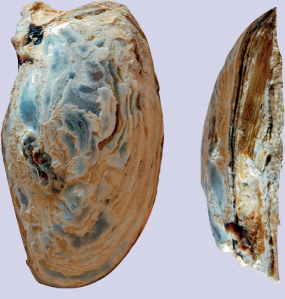
© C. APPLETON
Valves dorsoventrally elongated, with the lower one usually longer than the upper one, giving adults a characteristic asymmetry. Upper valve usually abraded and flattened, while lower valve concave to accommodate the animal. Size: 120×82mm in Namibia, but larger elsewhere. Biology: Young oysters often settle on top of dead shells to form banks of shell, usually well below the water surface. Widespread in Africa, southern limit being the Kunene River, Namibia, where populations are threatened by plans to dam the river. Eaten by people in central African countries and shells used as a source of lime. Namibian populations categorised as Endangered by IUCN.
Porcelain mussels
Family Corbiculidae
Small, solid, triangular mussels with shiny shells showing well-demarcated concentric ribs, but no other sculpture. Cardinal teeth strong and radially diverging, lateral teeth long. Viviparous. Two species in southern Africa, one in flowing, the other in standing water.
2 African porcelain mussel
Corbicula fluminalis
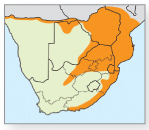
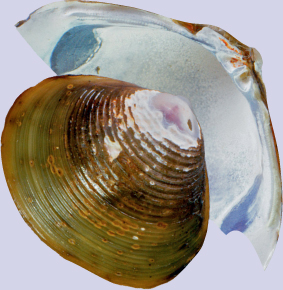
© N. MIRANDA
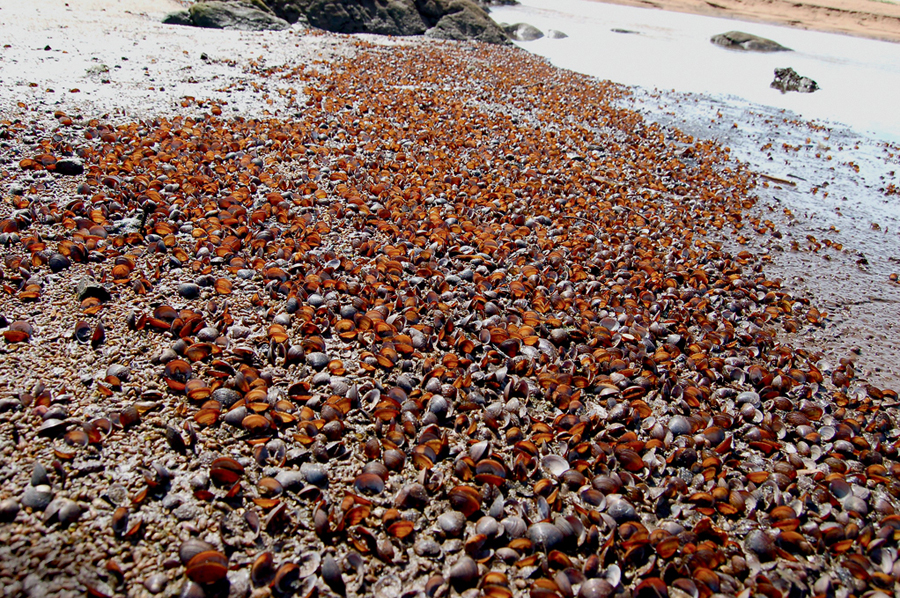
© C. GRIFFITHS
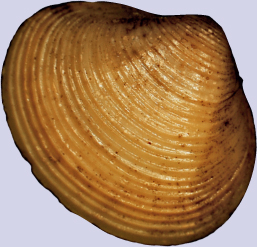
© C. APPLETON
Exterior of valves variable green, yellow or brown, large specimens with >35 ribs. Interior colour variable. Lateral teeth crenulated. Size: 17.7×14.6mm. Biology: Found in sand in lakes, rivers and shallow pans, often in large numbers, and often washed out in banks (2a) on shoreline. Previously called C. africana, but now considered to be conspecific with C. fluminalis, a widespread species originally described from the Middle East. Should not be confused with C. fluminea, a similarly named species from Asia. RELATED SPECIES: C. astartina (2b) is larger, with pale cream or yellow valves and white interior. It has <25 ribs, but these are stronger than in C. fluminalis. Widely distributed over the eastern half of the region. Uncommon.
Orb mussels
Family Sphaeriidae
Small fragile mussels with cardinal and lateral hinge teeth. Hermaphroditic and ovoviviparous. Three genera occur in flowing and standing water across much of southern Africa, but distributions of most species are poorly known. Genera distinguishable by their shells. Members of two, or all three, genera may occur together.
3 Orb mussel
Sphaerium capense
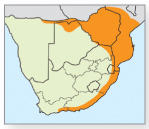

© C. APPLETON
Valves rounded, whitish and inflated with beaks on, or just posterior to, median vertical line. Size: Up to 9mm. Biology: Found in sand in standing and slow-flowing water, also in cryptic habitats, such as crevices between the rhizomes of papyrus sedges. Probably the most widespread orb mussels. RELATED SPECIES: S. incomitatum is similar in size, but more oval in shape, and its beaks are slightly posterior to vertical midline. Often occurs together with S. capense.
4 Fingernail mussel
Eupera ferruginea
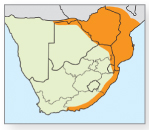
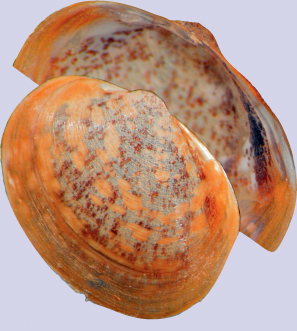
© N. MIRANDA
A distinctive species, with rhomboidal brown valves with raised growth lines and darker radiating flecks. Beak anterior to median vertical line. Size: Up to 7mm. Biology: Often found in mud or sandy mud with organic debris. May attach to submerged plants such as Ceratophyllum (p.302, 2) and Myriophyllum (p.304, 1) by means of byssus threads.
5 Pea mussels
Pisidium species
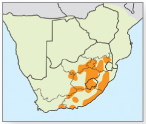
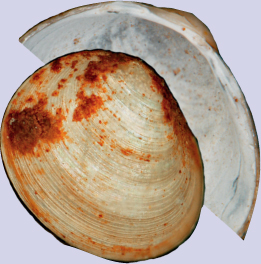
© C. APPLETON
Typically have globose whitish valves, with the beak usually well posterior to median vertical line. Sculpture generally lacking. Often found with a reddish deposit adhering to posterior half of shell – that part protruding into the water from the sediments. Size: Up to 6mm. Biology: Found in sandy mud in flowing and standing water, sometimes in large numbers. RELATED SPECIES: Eight species are known, but are difficult to identify. Two of these have sculptured shells: P. costulosum, with concentric ribs, and P. reticulatum, with a reticulate pattern.